The Knob-Billed Duck, also known as the African Comb Duck, is captivating with its unique features and behaviors.
Sporting a distinctive knob at the base of its bill, this waterfowl species exhibits striking sexual dimorphism, with males showcasing more giant knobs and vibrant plumage.
With an impressive ability to reach up to 50 miles per hour in flight, these ducks navigate their diverse habitats across Sub-Saharan Africa, South Asia, and parts of South America.
Their adaptability to wetland environments and their role in seed dispersal and insect control underscores their ecological significance.
Despite their global distribution, Knob-Billed Ducks face habitat loss and hunting threats, emphasizing the importance of conservation efforts to safeguard this remarkable species.
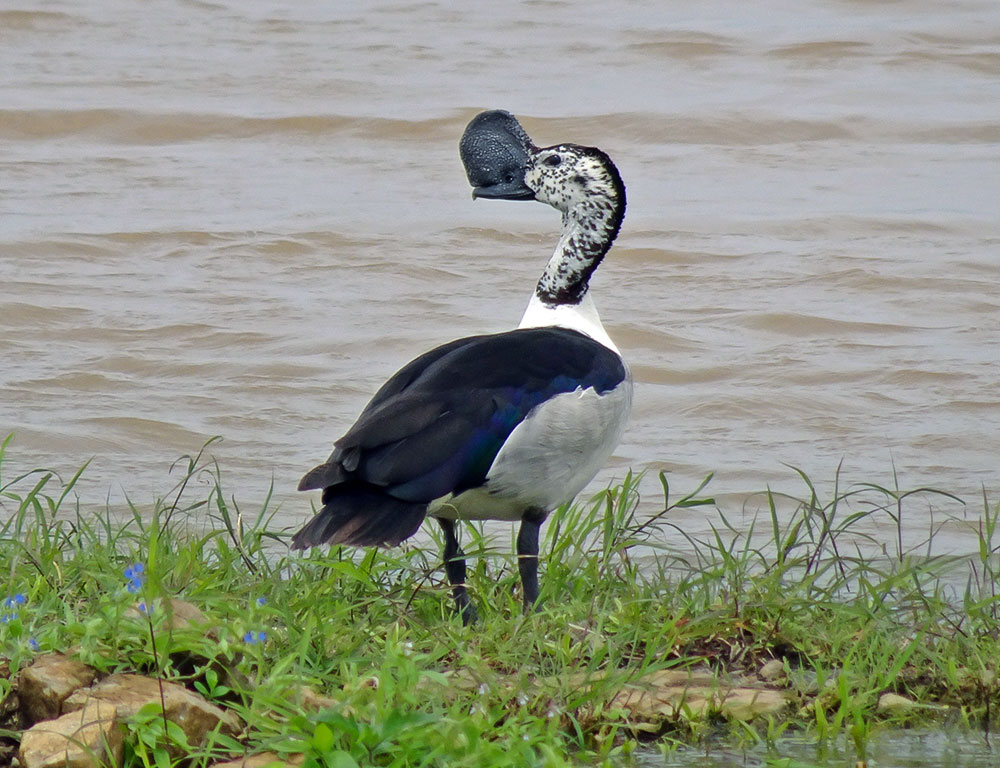
Physical Characteristics of Knob-Billed Duck
The Knob-Billed Duck, also known as the African Comb Duck, possesses several distinctive physical characteristics that make it easily recognizable.
Here’s an overview of its physical features:
Knob on the Bill
One of the most striking features of the Knob-Billed Duck is the prominent knob located at the base of its bill. This knob is larger and more pronounced in males than in females. It is made of soft tissue and varies in size among individuals.
Sexual Dimorphism
Knob-Billed Ducks exhibit sexual dimorphism, with males generally being larger and having more pronounced knobs on their bills compared to females. Females typically have smaller knobs or lack them altogether.
Size
Knob-Billed Ducks are medium to large-sized ducks. On average, they measure between 56 to 76 centimeters (22 to 30 inches) in length.
Weight
Adults of this species typically weigh between 1.03 to 2.9 kilograms (2.3 to 6.4 pounds).
Coloration
- Head: The head of the Knob-Billed Duck is white with dark spots, giving it a freckled appearance.
- Neck and Underparts: The neck and underparts of the bird are pure white.
- Upperparts: The upperparts of the duck are glossy blue-black with bluish and greenish iridescence, particularly prominent on the secondaries (lower arm feathers).
- Male vs. Female: In addition to the size difference, males typically exhibit more vivid coloration and a larger knob on the bill compared to females.
- Young Birds: Immature Knob-Billed Ducks have dull buff-colored underparts, dull brown upperparts, and an eyestripe.
Comparison with Comb Ducks
Knob-Billed Ducks are generally larger than comb ducks and have lighter flanks, usually light grey or whitish, compared to the darker plumage of comb ducks. Immature Knob-Billed Ducks may resemble large greyish females of the cotton pygmy goose (Nettapus coromandelicus).
Habitat and Distribution of Knob-Billed Duck
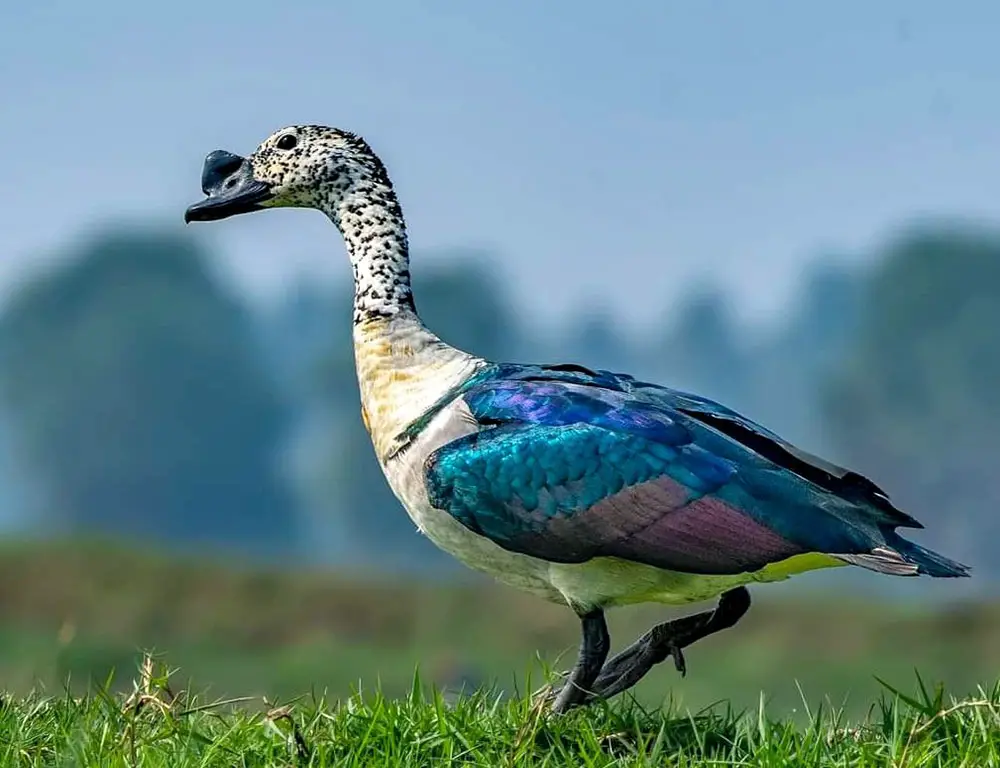
The Knob-Billed Duck, or the African Comb Duck, is distributed across various regions, primarily in wetland habitats.
Here’s an overview of its habitat and distribution:
Wetland Habitats
Knob-Billed Ducks are predominantly found in wetland environments, including freshwater and brackish water habitats. They inhabit a variety of wetland types, such as swamps, marshes, lakes, rivers, and floodplains.
Tropical and Subtropical Regions
Knob-Billed Ducks are native to tropical and subtropical regions of the world. They are commonly found in parts of Africa, Asia, and South America, where suitable wetland habitats are available.
Sub-Saharan Africa
This species is widespread across Sub-Saharan Africa, with populations in Kenya, Tanzania, Botswana, Zambia, Zimbabwe, South Africa, and others. They inhabit wetlands ranging from the Sahel region to southern Africa.
Madagascar
Knob-Billed Ducks also occur on the island of Madagascar, where they inhabit various freshwater habitats, including rivers, lakes, and wetlands.
South Asia
In South Asia, Knob-Billed Ducks are found in countries such as India, Pakistan, Bangladesh, and Sri Lanka. They inhabit wetlands, lakes, rivers, and marshes across the region.
Southeast Asia
Knob-Billed Ducks have been reported in Southeast Asian countries such as Thailand, Myanmar, Cambodia, Laos, and Vietnam. They occur in wetland habitats, rice paddies, and other freshwater ecosystems.
Occasional Sightings
While Knob-Billed Ducks primarily reside in their native range, occasional sightings have been reported outside their typical distribution areas. These sightings may occur in regions such as the Middle East, Australia, and parts of the Americas, though they are rare.
Diet and Feeding Habits of Knob-Billed Duck
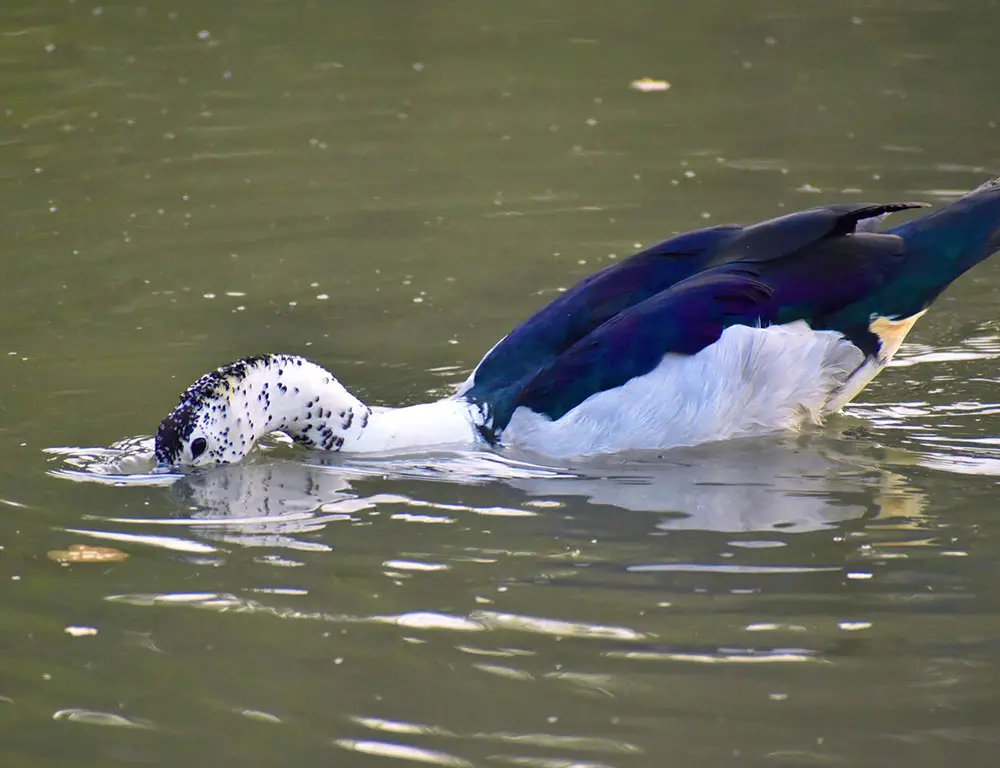
The Knob-Billed Duck, with its versatile diet, exhibits diverse feeding habits. Here’s an overview of its diet and feeding behavior:
Omnivorous Diet
Knob-Billed Ducks are omnivores, meaning they consume various plant and animal matter.
Plant Matter
Most of the Knob-Billed Duck’s diet consists of aquatic vegetation, including leaves, stems, seeds, and roots. They feed on aquatic plants in wetland habitats, such as grasses, sedges, and water lilies.
Invertebrates
In addition to plant material, Knob-Billed Ducks consume various invertebrates, including insects, crustaceans, mollusks, and other tiny aquatic organisms. They may forage for invertebrates in mud, shallow water, or along the water’s edge.
Small Fish
While plant matter and invertebrates form the bulk of their diet, Knob-Billed Ducks may also opportunistically feed on small fish. They may catch fish near the water surface or forage for fish eggs.
Feeding Behavior
Knob-Billed Ducks are dabblers, meaning they primarily feed by tipping forward into the water, leaving only their tail end visible above the surface.
This feeding behavior allows them to access food items on or near the water’s surface, including aquatic vegetation and invertebrates.
Filter Feeding
Their bill structure is adapted for filter feeding, allowing them to sift through water and mud to extract food particles. This enables them to feed on various tiny organisms and organic matter in wetland habitats.
Feeding in Different Seasons
Knob-Billed Ducks may alter their feeding habits depending on seasonal changes and food availability. During dry seasons, when food sources are scarce, they may travel long distances for suitable feeding grounds.
Reproduction and Nesting of Knob-Billed Duck
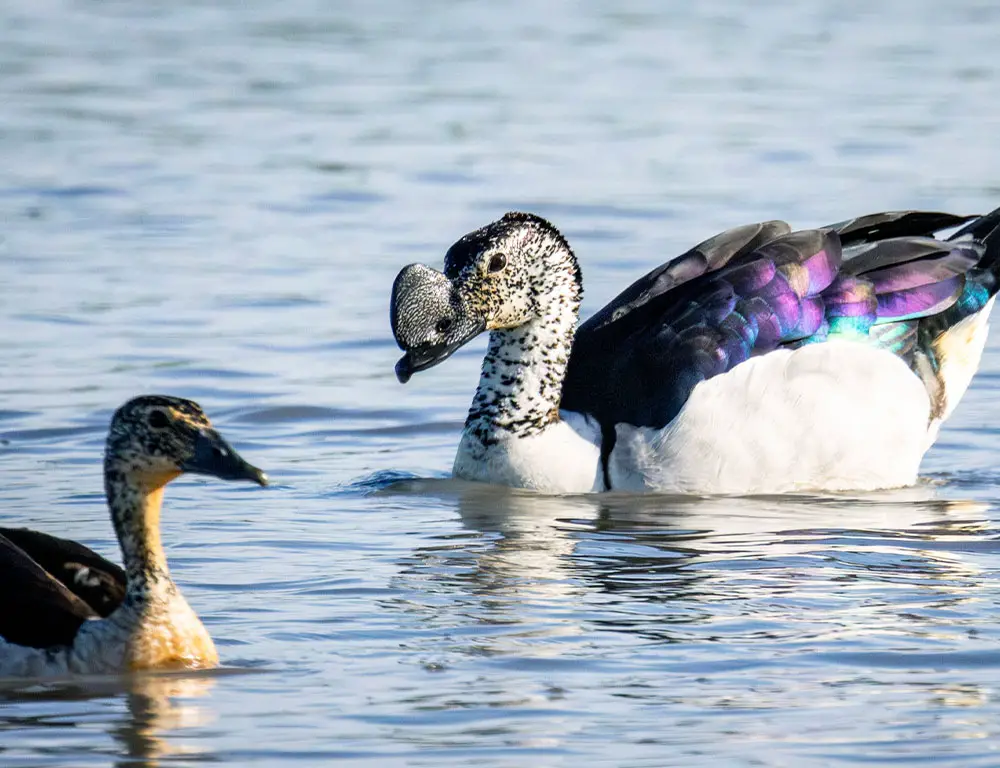
The reproduction and nesting behavior of the Knob-Billed Duck are fascinating aspects of its biology. Here’s an overview:
Breeding Season
Knob-Billed Ducks typically breed during the wet season or the beginning of the dry season in their native habitats. The timing of breeding can vary depending on local environmental conditions and the availability of resources.
Courtship
Male Knob-Billed Ducks engage in courtship displays during the breeding season to attract females. These displays may involve vocalizations, head bobbing, and other behavioral cues to establish dominance and attract mates.
Polygynous Mating System
Unlike many duck species that form monogamous pairs, Knob-Billed Ducks exhibit a polygynous mating system, where one male may mate with multiple females during a single breeding season. This can lead to complex social dynamics within breeding groups.
Nesting Sites
Female Knob-Billed Ducks are responsible for selecting and building nests. They typically construct nests near water bodies using plant material such as grasses, reeds, and other vegetation. Nests are often located over water for protection against predators.
Egg Laying
Once the nest is constructed, the female lays a clutch of eggs, typically ranging from six to fifteen eggs. The exact number of eggs may vary depending on environmental conditions and the female’s health and age.
Incubation
After laying the eggs, the female is responsible for incubating them. She incubates the eggs for about 28 to 30 days, during which she remains in the nest to keep the eggs warm and protected.
Hatching and Rearing
After the incubation period, the eggs hatch, and the ducklings emerge. Knob-Billed Ducklings are precocial, meaning they are born with down feathers and are capable of moving and feeding on their own shortly after hatching.
The female leads the ducklings to water, where they begin to forage and grow.
Parental Care
While the female cares for the ducklings, the male may continue to mate with other females or defend the territory. Knob-Billed Ducks exhibit limited parental care compared to other waterfowl species, with the female primarily responsible for rearing the offspring.
Conservation Status of Knob-Billed Duck
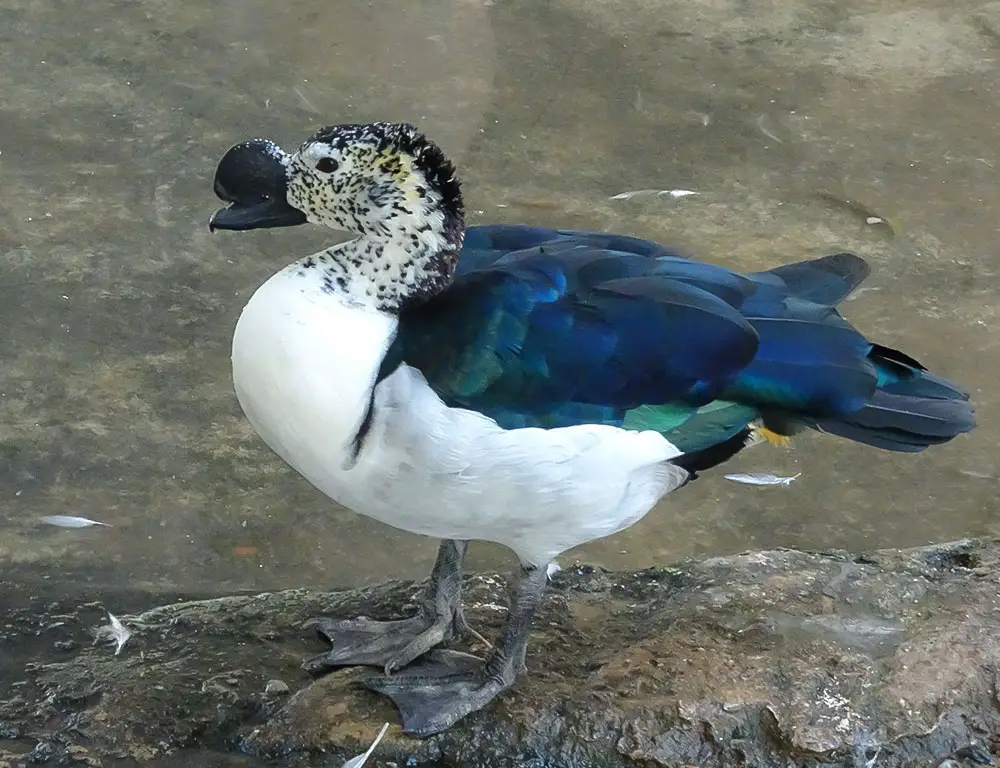
The conservation status of the Knob-Billed Duck, also known as the African Comb Duck, is classified as “Least Concern” according to the International Union for Conservation of Nature (IUCN).
Here’s an overview of its conservation status and related considerations:
Least Concern Status
The Knob-Billed Duck is categorized as Least Concern due to its relatively large population size and widespread distribution across its range. While specific populations may face localized threats, the species does not meet the criteria for a higher-risk category.
Population Trends
Overall, the population trend of Knob-Billed Ducks is stable. However, localized declines may occur in certain regions due to habitat loss, hunting pressure, and other factors.
Habitat Loss
One of the primary threats to Knob-Billed Ducks is habitat loss and degradation. Wetland habitats, which are crucial for the species, are increasingly being converted for agriculture, urban development, and other human activities.
Loss of wetlands can result in reduced breeding and foraging habitat for Knob-Billed Ducks.
Hunting and Harvesting
Knob-Billed Ducks are hunted for food and sport in some areas of their range.
While hunting pressure may not significantly threaten the species globally, localized overexploitation can impact local populations, particularly in areas with high pressure and limited regulatory measures.
Invasive Species
Introduced predators and competitors, such as invasive mammals (e.g., rats, cats) and invasive plant species, can negatively impact Knob-Billed Duck populations by preying on eggs and young, competing for resources, and altering habitat structure.
Climate Change
Climate change poses additional challenges to Knob-Billed Ducks and their habitats. Shifts in temperature and precipitation patterns can alter wetland ecosystems, affecting food availability, nesting success, and overall habitat suitability for the species.
Conservation Efforts
Conservation efforts to protect wetland habitats and manage water resources are essential for the long-term conservation of Knob-Billed Ducks. These efforts may include habitat restoration, protected area management, and sustainable land-use practices.
Additionally, measures to regulate hunting and control invasive species can help mitigate threats to Knob-Billed Duck populations.
FAQs
Are Knob-Billed Ducks endangered?
No, Knob-Billed Ducks are classified as Least Concern on the IUCN Red List, indicating that they are not facing imminent threats to their survival.
What is the lifespan of a Knob-Billed Duck?
Knob-Billed Ducks typically have a lifespan of around 10 to 15 years in the wild. However, individuals in captivity may live longer with proper care and management.
How do Knob-Billed Ducks communicate with each other?
Knob-Billed Ducks communicate through various vocalizations, including soft whistles by males and raspy “quacks” by females. These vocalizations are used for social interactions and during courtship displays.
Do Knob-Billed Ducks migrate?
While Knob-Billed Ducks may exhibit some seasonal movements in response to changing environmental conditions, they are generally considered non-migratory or only partially migratory, with populations in some regions being more sedentary than others.
What predators do Knob-Billed Ducks face in the wild?
Knob-Billed Ducks face predation from various terrestrial and avian predators, including mammals such as foxes and raccoons, as well as birds of prey such as eagles and hawks.
To Recap
The Knob-Billed Duck is a remarkable testament to the diversity and wonder of the avian world. Its distinctive knob, striking plumage, and agile flight make it a captivating subject for bird enthusiasts and researchers alike.
As a polygynous species, its complex mating dynamics further intrigue its behavior. Found across diverse wetland habitats in Africa, Asia, and South America, the Knob-Billed Duck plays a vital ecological role in seed dispersal and insect control.
However, challenges such as habitat loss and hunting underscore the need for continued conservation efforts.
By raising awareness, protecting critical habitats, and implementing sustainable practices, we can ensure the preservation of this fascinating species for generations to come, enriching our understanding of and connection to the natural world.